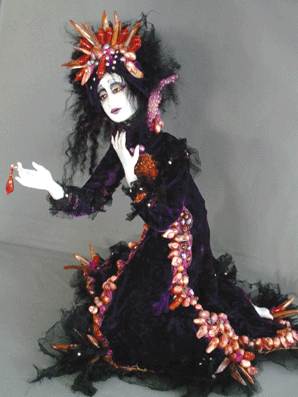Dolls are seldom seen as art by the general public and the larger art community. It’s an interesting phenomenon to me. Well-executed dolls require mastery of far more artistic skills than required of, say, a painter—designing, painting, sculpting, wig-making, costuming and engineering, numbering among them. Yet, dolls are often viewed as eccentric, inferior and sentimental, and relegated to some non-lofty, non-art category.
But clearly anyone who doesn’t view dolls as art hasn’t seen an Iacono, Ortiz, Johnston, Dennis, Günzel , Daanen or Dye, for instance (just to name a few!)—all inarguably top-of-the-line artists who create masterpieces.
And manufacturers like Tonner Doll Co., Integrity Toys, Goodreau Doll and Kish & Co.—well, their glorious vinyl and resin renderings began their existence as original art, much like the reproduced prints that hang above most folks’ couches and no one hesitates to classify as “art”—however loosely used.
It’s been with some frustration that I’ve witnessed the extremely niche and segmented nature of the doll industry. Why don’t art dolls have a significant presence at arts and crafts fairs? Why does medium play such a big role in determining whether a piece is a “sculpture” or “doll” and thereby assigning its audience and relevance in the art world?
At one point, I became aware of a high-end New York City gallery exhibiting a doll artist’s work. I wanted to cover the exhibit in DOLLS magazine. The gallery owner reacted with disdain: He made it clear DOLLS magazine was no place to showcase his artist’s work—it was “art” not “dolls” he informed me. Ironic, considering the artist had made her debut in DOLLS magazine years prior.
And it’s been one of many cases I’ve seen indicating a similar mentality during my tenure with DOLLS magazine. I feel it’s unfortunate because dolls don’t get the credit they deserve, and the industry is thereby stunted and unable to bloom to its fullest potential.
The issue niggles at my brain, and I toy with ideas of how we as an industry, can transcend beyond a niche hobby that appeals to a niche group to something bigger and more widely recognized by the art industry.
Recently, a friend brought Ron Mueck to my attention. Dubbed a “hyperrealist sculptor,” the artist creates works using resin, silicone and mixed media—all materials commonly used by dollmakers. Usually he integrates soft hair and costuming (not sculpted)—both elements of a “doll.”
His works could be called art dolls. Yet they are most definitely not referred to as such. I wonder … how has he transcended the lowly doll world?
Photo Caption
I look at this OOAK polymer clay piece, The Offfering, by Marilyn Radzat and wonder how it could ever not be considered art.




